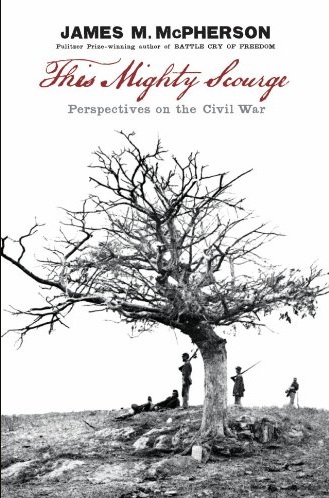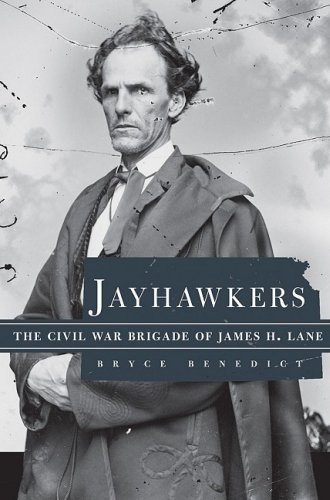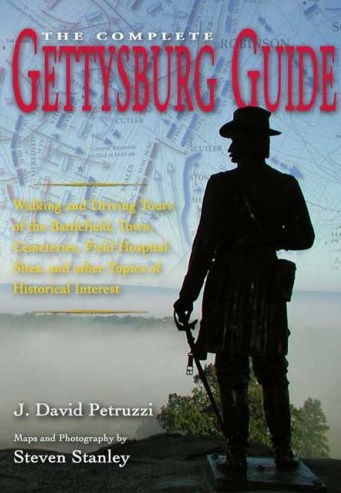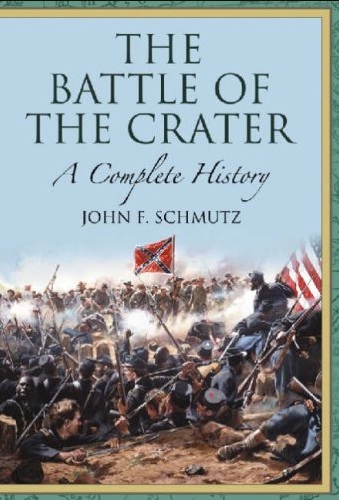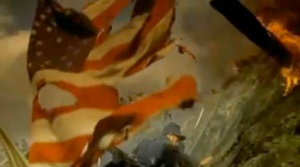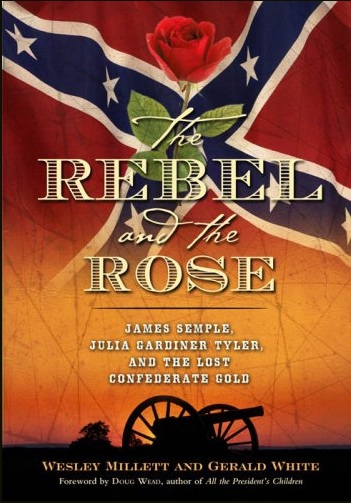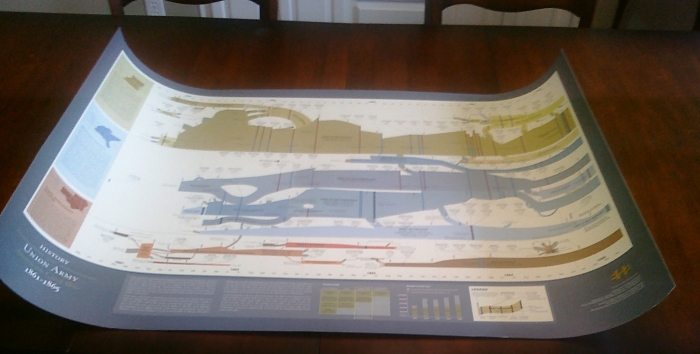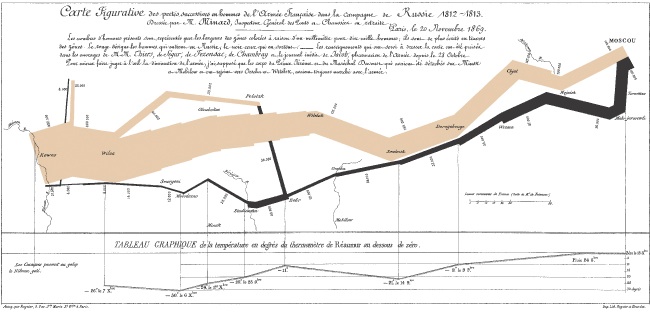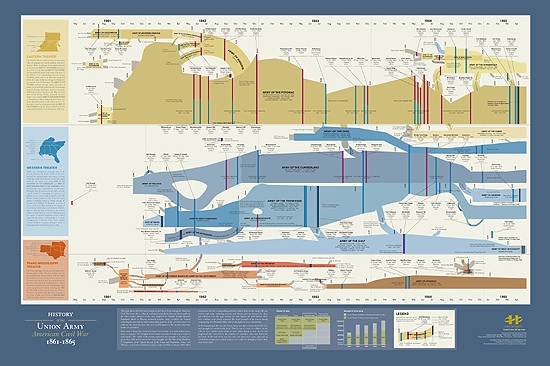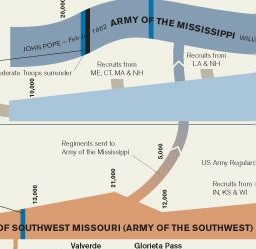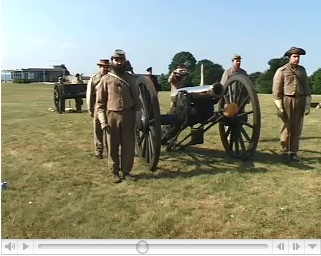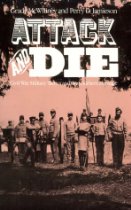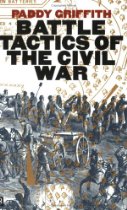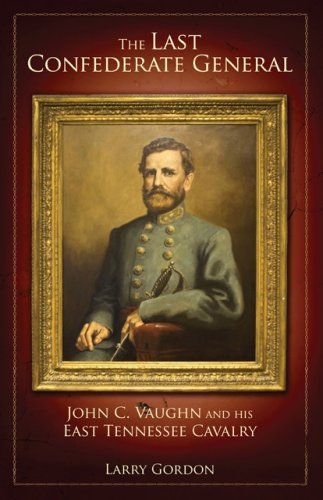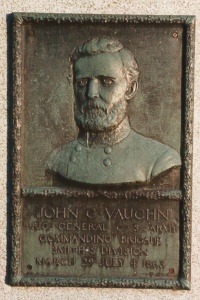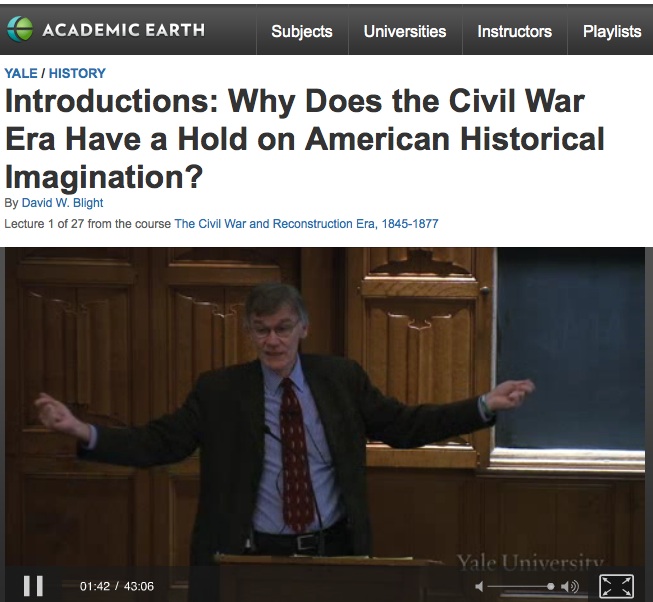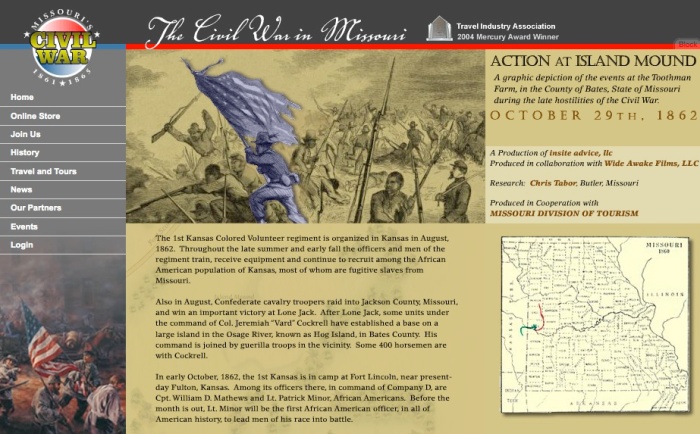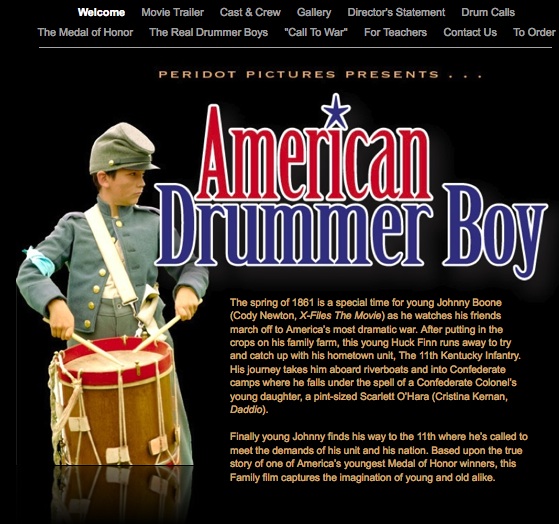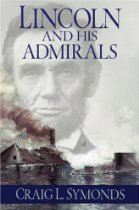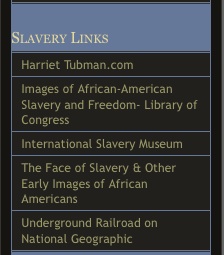Archive for the ‘Civil War’ Category
New in Paperback – This Mighty Scourge: Perspectives on the Civil War
The good folks at Oxford University Press recently sent me a copy of the new paperback edition of James McPherson’s This Mighty Scourge: Perspectives on the Civil War. First published in 2007, it comprises 16 essays in which McPherson attempts to answer the following questions:
- Why did the war come?
- What were the war aims of each side?
- What strategies did they employee to achieve these aims?
- How do we evaluate the leadership of both sides?
- Did the war’s outcome justify the immense sacrifice of lives?
- What impact did the experience of war have on the people who lived through it?
- How did later generations remember and commemorate that experience?
- Author: James M. McPherson
- Publisher: Oxford University Press
- ISBN13: 9780195392425
- ISBN10: 0195392426
- Paperback, 272 pages
- Sep 2009
I read the hardback version in 2007 and can highly RECOMMEND.
FYI – Amazon has the paperback version available for here for $12.21.
Jayhawkers: The Civil War Brigade of James Henry Lane
ISBN: 978-0-8061-3999-9
Cloth
352 pages
12 b&w illus., 1 map
Published: 2009-04-30
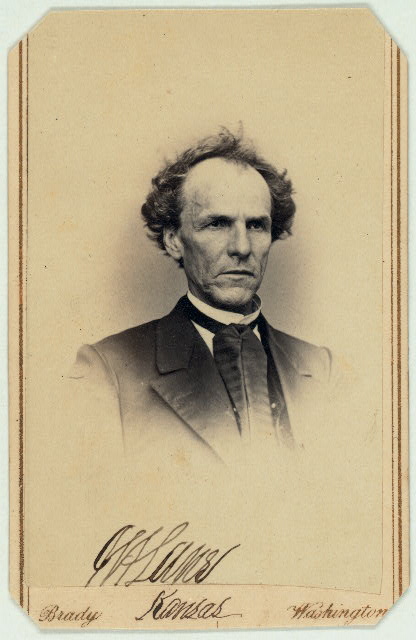
Carte d' visite of James Henry Lane, 1814-1866 Photographer: Brady National Photographic Art Gallery (Washington, D.C.) Library of Congress, Reproduction Number: LC-MSS-44297-33-037 (b&w negative)
The good folks at the University of Oklahoma Press sent me a review copy yesterday of Bryce Benedict’s Jayhawkers: The Civil War Brigade of James Henry Lane. In my usual fashion, I’m posting a few comments prior to a thorough reading.
I live on the borders of Missouri and Kansas so confess some considerable fascination with both Jim Lane and the evolution of war in the towns and farmlands of this part of the Western theater. Lane, a Kansas senator and strong advocate of Lincoln, was a player. Benedict identifies Lincoln himself as having given Lane authority “to raise and command two volunteer regiments.” Lane used them to harass Missourians with violence, theft, and destruction of property in a manner foreshadowing that of Sherman. Benedict posits that Lane thus embraced the notion of “total war” as a means of disabling the enemy’s war machine before it became more widely adopted as a strategy of the Union.
The photo of Lane on the cover (above) was a brilliant choice. After perusing the Library of Congress and finding his carte d’visite (left), it becomes clear that the look of the man fit his personality. In the words of Milton W. Reynolds, Lane was “weird, mysterious, partially insane, partially inspired, and poetic.” He described him as having lived a “…wayward, fitful life of passion and strife, of storm and sunshine a mysterious existence that now dwelt on the mountain-tops of expectation and the very summit of highest realization, and anon in the valley of despondency and deepest gloom.” [1] Lane committed suicide by shooting himself in the mouth with a pistol in 1866.
Author Bryce Benedict has produced a well researched work with notes for each chapter and three appendices including considerable information about fate of the casualties of Lane’s brigade, most of whom died from disease.
—–
For further reading, check out these books digitized for online reading at the Library of Congress.
[1] Connelley, William Elsey, (1855-1930) James Henry Lane, the “Grim chieftain” of Kansas (Topeka: Crane, 1899). The Library of Congress Digitized Book. LOC Call number: 9594581, Digitizing sponsor: Sloan Foundation
New Acquisition – The Complete Gettysburg Guide
I made a number of new acquisitions over the past month. The latest arrived in the mail today and has been added to my virtual bookshelves here. I’m actually pretty excited by this purchase.
![]() .
.
The Complete Gettysburg Guide: Walking and Driving Tours of the Battlefield, Town, Cemeteries, Field Hospital Sites, and other Topics of Historical Interest
Format: Hardcover
Price: $39.95
ISBN: 978-1-932714-63-0
Published: 2009-06-01 by Savas Beatie
Language: English
Binding: Hardcover
Pages: 320
Dimensions: 7 X 10
Petruzzi
J. David Petruzzi (Author) who blogs at Hoofbeats and Cold Steel here.
Stanley
and Steven Stanley (Maps and Photography) 62 photos and 70 full color maps
Books for class arrive! Civil War Command and Leadership
Ah… the “ding dong” of the door and the Amazon boxes thump against the door. Love it.
Full disclosure…I had to get some of these from resellers.
Here’s the stack.
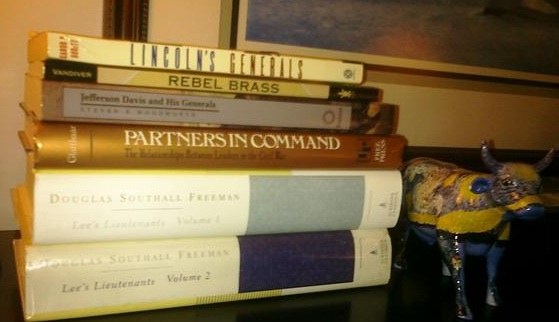
Note I bought the full three volume version of Lee’s Lieutenants (Vol 3 not pictured here). All books on the list can be seen on my virtual bookshelves here.
For more on my upcoming class, see the post below or “the courses” page here.
Stephen Woodworth to Teach Civil War Command and Leadership
The Battle of the Crater: A Complete History
- Title: The Battle of the Crater: A Complete History
- Author: John F. Schmutz
- Published on: 2009-01-19, McFarland & Company, Inc., Publishers
- Binding: Hardcover
- 428 pages
- ISBN-10: 0786439823
- ISBN-13: 978-078643982
I have happily received a review copy of John F. Schmutz’s The Battle of the Crater: A Complete History. I can be counted among those whose interest in this remarkable 9 hour battle was piqued after watching the mesmerizing opening sequence of the film based on Charles Frazier’s Cold Mountain.
It would be hard to find a similar military event in history that paralleled this one in terms of overwhelming potential for success run amok. Schmutz’s use of an opening quote about the July 30, 1864 battle by Ulysses S. Grant perhaps says it best…
The loss in the disaster of Saturday last foots up about 3,500, of whom 450 men were killed and 2,000 wounded. It was the saddest affair I have ever witnessed in the war. Such an opportunity for carrying fortifications I have never seen and do not expect again to have.
– Lieutenant General Ulysses S. Grant to Major General
Henry W. Halleck, August 1, 1864.
According to Schmutz, his interest in the Battle of the Crater began with the discovery that he had “two direct ancestors in the battle, one with the 14th New York Heavy Artillery, which at the last minute, and without any preparation or forewarning, was chosen to lead the assault, with disastrous consequences.” (Preface) This seed germinated into one of the first studies to take a broad-brush approach to the battle, examining the events leading up to it, the country’s mood in its now third year of civil war, brutality committed against black troops, atrocities perpetrated by both sides, first-hand accounts, and the impact of the battle “on the body politic of both sides.”
Schmutz appropriately gives readers a sense for war in the trenches that were part of the Siege of Petersburg.
As both sides dug even deeper entrenchments and more infantry obstacles, the rolling farmland east and south of the city was soon churned into scenes resembling a moonscape. These tandem ramparts ran for twenty-six miles, crossed two major rivers, and traversed parts of four Virginia countries, from White Oak Swamp, east of Richmond, across Bermuda Hundred and south of the Jerusalem Plank Road below the city. No campaign of the war quite equaled the siege of Petersburg, which was the object of the longest military action ever waged against an American city. More battles were fought and more lives lost there than in the defense of any better-known Southern cities such as Richmond, Vicksburg or Atlanta. (p. 40)
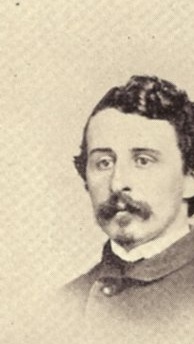
Henry Pleasants
The excellent chapter titled “The Earth Movers,” reveals how Lt. Col. Henry Pleasants and the men of the 48th Pennsylvania, many of them coal miners, accomplished what Meade’s engineers mockingly called impossible, the building of a lengthy tunnel without detection by the Confederates. Receiving literally no support from Meade or his men, Pleasants overcame every challenge with ingenuity and innovation. As an example, he used a combination of miner’s bellows and fire to create draft to circulate air through a shaft built into the tunnel wall. This bit of creative thinking, the details of which are a must read, became what Schmutz called Pleasants’ “greatest engineering feat.” (p. 61)
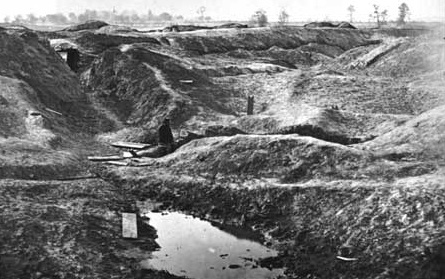
From the National Park Service site on the Petersburg National Battlefield, "The Crater as it appeared in 1865. The Union soldier seated at the end of the tunnel gives an idea of the size of the Crater." Click the image to go to the site.
Of note, Schmutz provides an impressive set of references in his appendices, something I always value in a book of serious history. These include:
- Organization of Opposing Forces on July 30, 1864 including Union and Confederate Corps, Division, and Brigade, and in some cases Company commanders and officers
- Casualty counts by Corps, Division, Brigade and Unit
- Medal of Honor Recipients and Confederate Roll of Honor Recipients by Corps including a brief statement about why they received the award
Union Officers Killed or Mortally Wounded by Corps, Division, and Brigade - Full and extensive Chapter Notes
- An impressive Bibliography which demonstrates the extent of primary sources used in Schumtz’s research
I greatly look forward to fully reading this book and fully expect that a Highly Recommend will be forthcoming.
Kevin Levin has recently provided a review of The Battle of the Crater: A Complete History on H-Net here.
Stephen Woodworth to Teach Civil War Command and Leadership
I just registered for my next course: Civil War Command and Leadership. Here’s a quick summary: “a study of national, theater, and operational command structures of the Union and Confederacy, the leadership styles of key military leaders on both sides, and the evolution of command and control in the war. Major themes include the relationship between the commanders in chief and the generals who led the armies in the field, the relationships between the generals themselves, and the ways in which the relationships described above either served to facilitate or debilitate the causes those commanders served.”
I am VERY excited about the professor, Steven E. Woodworth!

- Ph.D., Rice University, 1987
- Professor of history at Texas Christian University
- Author, co-author, or editor of twenty-seven books you can view here
- Two-time winner of the Fletcher Pratt Award of the New York Civil War Round Table (for Jefferson Davis and His Generals and Davis and Lee at War)
- Two-time finalist for the Peter Seaborg Award of the George Tyler Moore Center for the Study of the Civil War (for While God Is Marching On and Nothing but Victory)
- Winner of the Grady McWhiney Award of the Dallas Civil War Round Table for lifetime contribution to the study of Civil War history
I’ve added a new page on my bookshelves to show the booklist for the course as it stands today which you can access here.
The Rebel and the Rose
I was pleased to recently receive a review copy of the book The Rebel and the Rose: James Semple, Julia Gardiner Tyler, and the Lost Confederate Gold. Its authors, Wesley Millett and Gerald White, are profiled on the book’s attractive website here. The book is currently published by Turner Publishing Company.
It promises insight into several interesting topics:
- the flight of Jefferson Davis at war’s end
- the disappearance of the Confederate war chest
- a romantic liaison with presidential ties
More to come…
Military History Word of the Day: “Refuse”
Refuse
Military. to bend or curve back (the flank units of a military force) so that they face generally to the flank rather than the front.
refuse. Dictionary.com. Dictionary.com Unabridged (v 1.1). Random House, Inc.http://dictionary.reference.com/browse/refuse (accessed: August 08, 2009).

It is not surprising that McClellan did not immediately decide to employ his left wing under Franklin to relieve Harpers Ferry. In focusing on Frederick for the past several days, the Federal right had not only advanced quicker and farther, but the left had angled northward toward Frederick. In consequence Burnside was now considerably nearer Harpers Ferry than Franklin. Moreover, McClellan needed to refuse his left flank along the Potomac until he learned the meaning of the rumor that Jackson had recrossed the river at Williamsport. Lincoln may have jumped to the conclusion that the Confederates were retreating, but the possibility of a turning movement could not be dismissed lightly.
1. Joseph L. Harsh, Taken at the Flood : Robert E. Lee and Confederate Strategy in the Maryland Campaign of 1862 / [book on-line] (Kent, OH: Kent State University Press, 1999, accessed 8 August 2009), 209-210; available from Questia, http://www.questia.com/PM.qst?a=o&d=102364919; Internet.
Staff Ride Guide – Battle of Antietam

Informative read about the Battle of Antietam prepared as a “Staff Ride Guide” by Ted Ballard, CENTER OF MILITARY HISTORY, UNITED STATES ARMY. This assisted, among other things, with my understanding of artillery and particularly how units were organized who supported the guns. Interesting factoids from page 83 -84 (note this entire book is available online by clicking on the book image above):
“The artillery of both armies was generally organized into batteries of four or six guns. Regulations prescribed a captain as battery commander, while lieutenants commanded two-gun “sections.” Each gun made up a platoon, under a sergeant (“chief of the piece”) with eight crewmen and six drivers.
For transport, each gun was attached to a two-wheeled cart, known as a limber and drawn by a six-horse team. The limber chest carried thirty to fifty rounds of ammunition, depending on the size of guns in the battery. In addition to the limbers, each gun had at least one caisson, also drawn by a six-horse team. The caisson carried additional ammunition in two chests, as well as a spare wheel and tools. A horse-drawn forge and a battery wagon with tools accompanied each battery. A battery at full regulation strength included all officers, noncommissioned officers, buglers, drivers, cannoneers, and other specialized functions and might exceed 100 officers and men. With spare horses included, a typical six-gun battery might have 100-150 horses.
A battery could unlimber and fire an initial volley in about one minute, and each gun could continue firing two aimed shots a minute. A battery could “limber up” in about one minute as well. The battery practiced “direct fire”: the target was in view of the gun. The prescribed distance between guns was fourteen yards from hub to hub. Therefore, a six-gun battery would represent a front of about 100 yards. Depth of the battery position from the gun muzzle, passing the limber, to the rear of the caisson was prescribed as forty-seven yards. In practice, these measurements might be altered by terrain.”
Gettysburg: The Film, The Books, The Battle
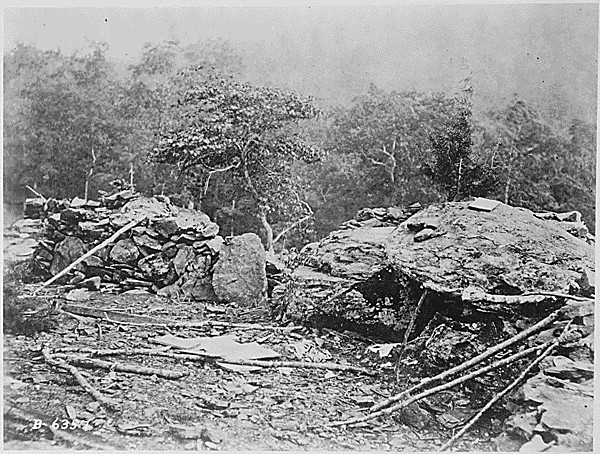
Little Round Top Union Breastworks (Source: The National Archives) Brady
Each July we bring out the film Gettysburg and watch it in a couple of sittings. (My husband can’t wait for the four plus hour epic to come out in Blu-ray.)
I’ll be the first to admit that it’s more than a bit hokey here and there but the scene of the defense of Little Round Top by the 20th Maine Volunteer Infantry Regiment is always a highlight.
My current reading for class discusses the legacy of bayonet charges from the Mexican War and the debate over the frequency of their use during the American Civil War still goes on. Undebatable is the inspired use of a downhill bayonet charge by Col. Joshua Lawrence Chamberlain and its standing on the list of well-known actions at Gettysburg.
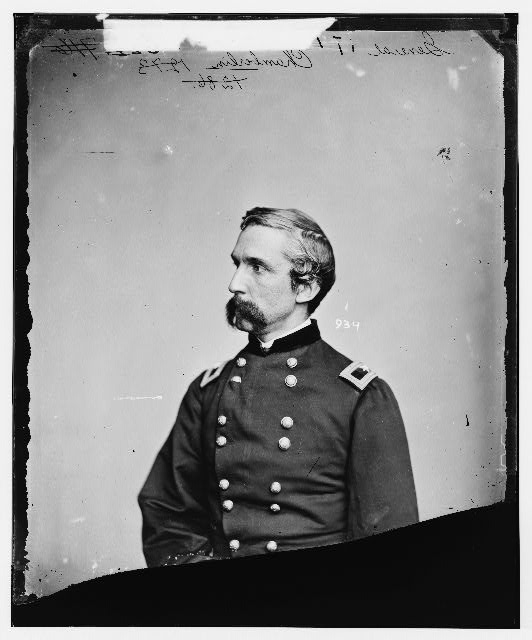
Joshua Lawrence Chamberlain
I’ve been enjoying the perspectives of several ACW bloggers on their top ten books on Gettysburg which Brett over a TOCWOC has nicely organized for us here.
Check them out. Very much worth perusing.
American Civil War Artillery Demonstration, Antietam National Park
Excellent demonstration of how a gun crew handled artillery during the American Civil War can be seen below.
Antietam Artillery Demonstration
Ranger Mannie Gentile has become an excellent film maker. His blog, My year of living Rangerously, remains one of my favorites.
Attack and Die

Confederate Dead, Spotsylvania Court House, Virginia
Currently reading… Attack and Die: Civil War Military Tactics and the Southern Heritage by Grady McWhitney and Perry D. Jamieson. Incredible statistics describing the carnage resulting from Confederate offensives against fortified positions.
Photo of Lt. General Grant’s Fascinating Staff at Center Point, Virginia
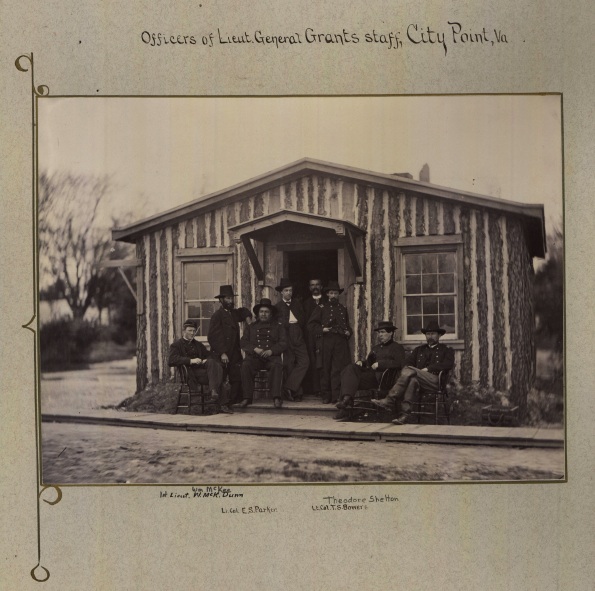
I ran across this excellent photo of Grant’s staff pictured below in City Point, Virginia on the Army Heritage Collection Online site. According to the writing on the matting, included are: 1st Lieut. William McKee Dunn, Jr. (seated left), Lt. Col. E. S. Parker (larger man seated to left of door), and Lt. Col. Theodore Shelton Bowers (standing to right of door). That accounts for only three of the eight men pictured although it’s unclear whether all of the men are in the military. A very similar photo appearing in the book, The Life of General Ely S. Parker, indicates that the building pictured was the headquarters of the Army of the Potomac and was taken in 1864 by legendary Civil War photographer Mathew B. Brady. (1) This would have been one of 22 log cabins that were built to house Grant and his staff and formed the headquarters on the James River. Originally quartered in tents, as the siege of Petersburg extended and the weather deteriorated, Grant had the cabins erected. His cabin had two rooms, one in the front for carrying on war matters and a room at the rear for his quarters. I am unsure whether this is Grant’s cabin. The town is known today as Hopewell. (2)
William McKee Dunn, Jr.: Undoubtedly the youngest of the men pictured, Dunn joined the army at age 18 as a private and became an aid-de-camp to General Sullivan in March of 1863 and then to Grant in October of the same year. He served with Grant through the rest of the war eventually being promoted to captain. Sources indicate that he had occasional charge of Grant’s son Jesse. (3)
Ely Samuel Parker: A highly educated Seneca Indian, Parker was refused entry to the bar and initially entry to the Union Army because of he was not considered an American citizen. He was trained as an engineer and became friends with Grant prior to the war. Grant brought him to his staff at Vicksburg. On August 30 1864, he was officially appointed as Grant’s private secretary by General Order No. 249. Parker eventually rose to the rank of Brevet Brigadier General. He was frequently referred to as simply “the Indian.” (1) His biography is available on Google Books here.
Theodore. Shelton Bowers: On March 8, 1866, the New York Times reported the horrific death of then General T. S. Bowers in an accident while attempting to jump on to the rail car carrying Grant after the party dropped Grant’s son at West Point. You can read that account here. (4)
Sources:
1 The life of General Ely S. Parker: Last Grand Sachem of the Iroquois and Grant’s Military Secretary, Arthur Caswell Parker, (Buffalo, New York: Buffalo Historical Association, 1919).
2 Grant’s Headquarters, a site maintained by the National Park Service accessed on June 28, 2009 here.
3 William McKee Dunn by William Wesley Woolen, (Knickerbocker Press: New York), 93 – 94, accessed online on Google books here, June 28, 2009.
4 “Particulars of the Death of Gen. T. N. Bowers,” New York Times, March 8, 1866, accessed online here, June 28, 2009.
Civil War Preservation Trust President Interview
Michael Noirot over at This Mighty Scourge has posted an interesting interview with the Civil War Preservation Trust‘s president, Jim Lighthizer. It’s presented in a series of podcasts and is well worth a listen. You can access it here or by clicking on the image below.
Up this Week: Battle Tactics of the Civil War
Up this week: Chapters 1 – 6 of Paddy Griffith’s Battle Tactics of the Civil War. Mr. Griffith was a lecturer at the Royal Military Academy Sandhurst.
- Published on: 2001-03-01
- Publisher: Yale University Press
- Original language: English
- Binding: Paperback
- 240 pages
Emulate Grant! Leadership in the American Civil War
I wrapped up reading Lincoln and His Generals by T. Henry Williams and found it quite good.
I confess to being impressed by the extent to which Lincoln became an able strategist by the mid-point of the war. No doubt contributing to this was Halleck’s liaise-faire attitude. Lacking a strong military leader and much in the way of battle successes, Lincoln obviously felt compelled to step in and fill the strategic voids for his armies.
I was also struck by the characteristics that Lincoln valued and devalued in his generals. The lesson would serve many aspiring to leadership today. The takeaway?
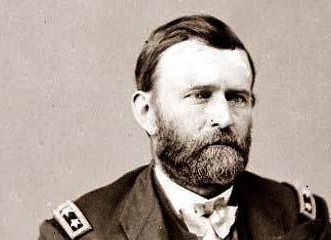
Emulate Grant!
Don’t whine.
Do the best you can with what you’ve been given.
Communicate minimally but effectively “up.”
Respect and follow the leadership of the man in charge when it is offered. Don’t argue with him excessively.
Don’t aspire to take his job, at least overtly.
Don’t criticize or blame others. Respect your subordinates enough to let them do their jobs.
Do not overly criticize them either. Control yourself and your emotions.
Be decisive.
Be manically focused on getting the job at hand done.
Be informed by the past but fully engaged in the realities of the present.
For Grant and Lincoln, this latter point meant something more than merely implementing Jominian tactics. It appears that together, they evolved toward the modern notion of war as “total” in Clausewitzian terms. Is it possible that only Lincoln saw this truth in the war’s earliest years? I say yes.
Excellent Description of the 2nd Battle of Corinth in “The State of Jones”
In June 6th’s post I mentioned I was reading a review copy of The State of Jones: The Small Southern County That Seceded from the Confederacy by Sally Jenkins and John Stauffer. This update: their description of the Battle of Corinth is outstanding, albeit gruesome. I will file the book in numerous places on my virtual bookshelves as it covers a great deal of ground: the experience of soldiers, rich versus poor in the military of the Confederacy, unionists in the South, the experience of slaves, etc., etc.

This sample of the telling of the Battle of Corinth…
“[Brigadier General Martin] Green ordered the men forward. ‘With a wild shout,’ the Mississippians leaped across a railroad cut with the rest of the brigade. A command came to charge at the the ‘double-quick.’
It was the last order that could be heard, as at least fifty Federal guns opened fire on them. the trembling thunder of artillery was joined by the shrieking, concussive outbursts of shells and the short, almost muffled spat-spat-spat of Springfield rifles, hammers hitting soft gunpowder, followed by the metallic raking of ramrods. ‘The very atmosphere seemed filled with shot, shell, grape and canister,’ General Green reported.
Suddenly it seemed as if they were in a rainstorm of blood. Horses plunged and caterwauled, and men screamed incoherently. There was something about such a charge that forced the breath from men’s throats, almost reflexively, without their even knowing it. As one Mississippi soldier recorded in his diary, ‘I always said, if I ever went into a charge, I wouldn’t holler. But the very first time I fired off my gun, I hollered as loud as I could, and I hollered every breath until I stopped!” (p. 33)
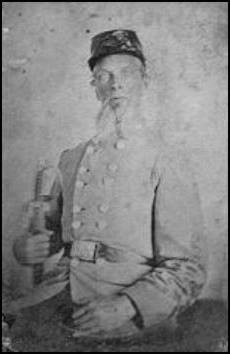
Brig. Gen. Martin E. Green
Maj. Gen. Earl Van Dorn (Army of West Tennessee) was later court-marshaled for his neglect in taking care of logistical details and forcing his army to march and fight the Battle of Corinth with insufficient water and food. The charges were dropped.

Maj. Gen. Earl Van Dorn
The State of Jones
The good folks at Doubleday sent me a review copy of The State of Jones: The Small Southern County That Seceded from the Confederacy by Sally Jenkins and John Stauffer. It is available for pre-order now from WigWags Books and will be published on June 23rd.
- Hardcover: 416 pages
- Publisher: Doubleday (June 23, 2009)
- Language: English
- ISBN-10: 0385525931
- ISBN-13: 978-0385525930
- Dimensions: 9.5 x 6.4 x 1.2 inches
This is the story of Newton Knight who was a Unionist living in Mississippi and strongly anti-slavery. The authors suggest that he was “the South’s strangest soldier.”
Some quick facts:
- In Jones County Mississippi, fifty-three men had not only fought as anti-Confederate guerrillas, but formally enlisted in the Union army in New Orleans
- Knight’s group of guerrillas “remained unconquered though surrounded by Confederate Armies from start to finish.”
- Jones was drafted into the Confederate army but refused to fight and eventually deserted.
- Knight had two families, one white and one black. His black family was with a slave named Rachel who was owned by his family and who helped him during the war. He acknowledged her children as his own.
I profess to getting behind in my reading for school because of this book. I promise to write a proper review after I’m finished reading it. I can say that it is VERY well written.
Newton Knight’s story is being made into a film currently in production. Filmmaker Gary Ross is writer, director, and one of several producers.
Sally Jenkins is an award-winning journalist currently with the Washington Post. She has authored eight books, three of New York Times bestsellers.
![]()
John Stauffer is Professor of English and African American Studies and Chair of the Committee on Higher Degrees in the History of American Civilization at Harvard. ![]()
His prior book, GIANTS: The Parallel Lives of Frederick Douglass and Abraham Lincoln, I mentioned in a previous post which you can read here. 
Railroad Generalship: Foundations of Civil War Strategy

I ran across an excellent monograph yesterday by Dr. Christopher R. Gabel titled “Railroad Generalship: Foundations of Civil War Strategy.” It is available in its entirety on the Command and General Staff College’s Combined Arms Research Library here. It includes maps and illustrations.
The following is the foreward by Jerry D. Morelock , Colonel, Field Artillery and Director of the Combat Studies Institute.
“According to an old saying, “amateurs study tactics; professionals study logistics.” any serious student of the military profession will know that logistics constantly shape military affairs and sometimes even dictate strategy and tactics. This excellent monograph by Dr. Christopher Gable shows that the appearance of the steam-powered railroad had enormous implications for military logistics, and thus for strategy, in the American Civil War. Not surprisingly, the side that proved superior in “railroad generalship,” or the utilization of the railroads for military purposes, was also the side that won the war.”
Gabel provides some astonishing statistics which illustrate why railroads challenged traditional strategic direction during the Civil War. He contends that the net effect of “the advent of the steam-powered railroad” was a boost in logistical output by at least a factor of ten. The impact on strategy in the Civil War was staggering. “Most notably, the railroad increased enormously the geographical scale of military operations.” Armies got larger. Sherman’s offensive campaign used 100,000 men and 35,000 animals. His supply line consisted of a single-track railroad extending 473 miles from Atlanta to his main supply base at Louisville. Sherman estimated that this rail line did the work of 36,800 wagons and 220,800 mules!”
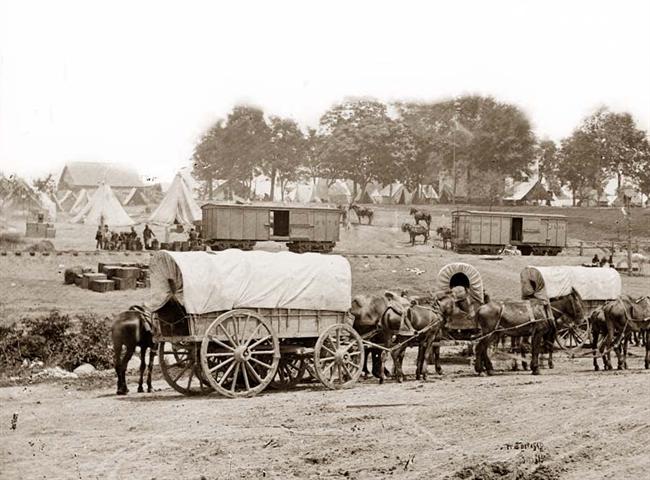
Civil War Wagons
For those of you really into military strategy, Gabel provides a simple yet effective illustration of “interior lines” and “exterior lines” and why railroads sometimes helped and other times hindered Civil War strategists who tried to use Jomini/Napoleonic concentration on “interior lines” strategy.
Regular followers of Wig Wags will know that I’ve posted on this fascinating topic before. See the page, Civil War Railroads here.
Highly recommend.
Christopher R. Gabel, “Railroad Generalship: Foundations of Civil War Strategy.” http://www-cgsc.army.mil/carl/resources/csi/gabel4/gabel4.asp#org, Accessed: May 24, 2009.
Civil War Naval History Fact of the Day
The U.S. fleet grew from 90 to 670 ships during the four years of the Civil War and from 7,500 to 51,500 sailors.
Archer Jones, Civil War Command and Strategy: The Process of Victory And Defeat, (New York: The Free Press, 1992), 139.
![the-fight-between-the-alabama-and-the-kearsarge-nh59354 "The Fight Between the Alabama and the Kearsarge" [NH59354]](https://wigwags.files.wordpress.com/2008/09/the-fight-between-the-alabama-and-the-kearsarge-nh59354.jpg?w=700)
Informal Leadership and Civil War Command
I’m reading the second half of Archer Jones’ Civil War Command and Strategy: The Process of Victory And Defeat this weekend. He makes an interesting point about the power of informal leadership over formal leadership positing that people find informal leaders just as they create informal organizations. He suggests that George McClellan provides one of the best examples.
As the creator and first commander of that Army [the Army of the Potomac], he had claims to loyalty which his charisma and the appeal of his Peninsula campaign’s strategy intensified. Even after he had left the command, his position of formal leadership, he continued to exercise great informal influence. This often took the form of the officers of the Army of the Potomac displaying hostility to the secretary of war and an unshakable allegiance to the strategy of the Peninsula campaign. No successor in command could ever displace him as the army’s informal leader, a situation which made it difficult for every subsequent commander and limited the ability of the president ad the general in chief to enjoy any widespread, deep-rooted support.
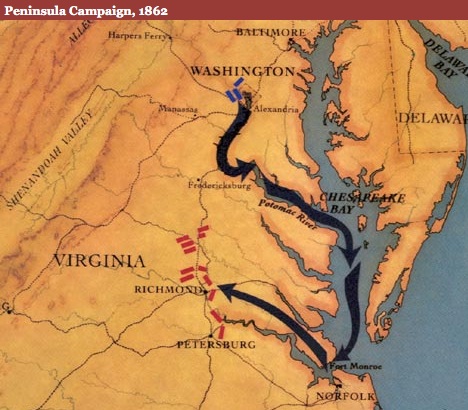
Source: PBS: http://www.pbs.org/civilwar/war/map3.html#
 In like fashion, he suggests that Lee uprooted Johnston’s memory because of the three campaigns he conducted in four months and put Lee in the position of informal and formal leader of the Army of Northern Virginia.
In like fashion, he suggests that Lee uprooted Johnston’s memory because of the three campaigns he conducted in four months and put Lee in the position of informal and formal leader of the Army of Northern Virginia.
Do you agree with his assessment?
 Archer Jones, Civil War Command and Strategy: The Process of Victory And Defeat, (New York: The Free Press, 1992), 126.
Archer Jones, Civil War Command and Strategy: The Process of Victory And Defeat, (New York: The Free Press, 1992), 126.
Civil War High Tech: Excavating the Hunley and Monitor from MIT World
Always on the hunt for opportunities to inform my understanding of history, I’ve hit a gold mine. In addition to my fascination with the Civil War, I am equally passionate about maritime history and am a degreed engineer. Those three fields of study converge in a fascinating symposium hosted by the DeepArch Research Group in Technology, Archaeology and the Deep Sea at MIT in April 2003 which they have made available for viewing on MIT Earth (TM).
The symposium, Civil War High Tech: Excavating the Hunley and Monitor gives us an opportunity to hear from the senior archaeologist on the recovery of the C.S.S. Hunley, Maria Jacobsen. For those of you familiar with Civil War Naval history, the CSS Hunley will not be a new name. For those not, its story is nothing less than remarkable. A Confederate submarine, it was lost after driving a mine into the hull of USS Housatonic, detonating it, and sending the ship to the silty bottom of Charleston Bay in five minutes. But the Hunley was lost as well, only to be found, recovered, and excavated in the last decade or so.
I have made it through the first presentation on the Hunley (wow) and hope to watch the second half of the symposium on the Monitor. But for now, this from the MIT site:
Civil War High Tech: Excavating the Hunley and Monitor
- Moderator: Merritt Roe Smith
- Maria Jacobsen
David A. Mindell PhD ’96
Brendan Foley PhD ’03
About the Lecture
In the last few years, archaeologists have recovered two of the Civil War’s most ingenious inventions: the Union ironclad warship Monitor and the Confederate submarine Hunley. In this symposium panelists discuss the newest technology projects that have brought these inventions to light from the sea depths, and what they can teach about technology and the Civil War.
Submarine CSS H. L. Hunley [1863-1864]
- Submarine built by Horace L Hunley

- First submarine to destroy an enemy ship
- All three crews died aboard although several from the first crew were able to escape.
- Lost off of Charleston after sinking the USS Housatonic with a spar torpedo
- Remains discovered in 1995 by NUMA
- Recovered August 8, 2000
Photo credit: Confederate Submarine H.L. Hunley (1863-1864) U.S. Naval Historical Center Photograph [#NH999]
You may be interested in previous posts I’ve made on the Hunley. My first was the following:
On Dog Tags, Sunken Confederate Subs, and Graves Registration
Civil War Medicine
I’ve added a new book to my library, Civil War Hospital Sketches by Louisa May Alcott. I’ve also added a new virtual bookshelf titled “Civil War Medicine” which I looking for recommendations to fill.
The publication above, the Dover edition, is a replication of a book published by James Redpath, Boston, 1863. Most of the content was published originally in The Commonwealth, a well known Boston newspaper. Alcott wrote under a pseudonym and the entries record experiences during a six week period of service as a nurse at Washington Hospital in Washington, D.C. This from the cover…
A fiery baptism in the practice of nursing awaited her at Washington Hospital, were she arrived immediately after the slaughter of the Army of the Potomac at the battle of Fredericksburg. Alcott’s rapidly paced prose graphically depicts the facts of hospital life, deftly balancing pathos with gentle humor. A vivid and truthful portrait of an often overlooked aspect of the Civil War, this book remains among the most illuminating reports of the era’s medical practices as well as a moving testimonial to the war’s human cost.

Louisa May Alcott
Miss Alcott left the hospital after falling ill to fever and was never again to regain full health.
Civil War Hospital Sketches
Dover Evergreen Classics
- ISBN: 978-0-486-44900-5
- Published on: 2006-02-10
- Original language: English
- Binding: Paperback
- 80 pages
The Last Confederate General: John C. Vaughn and His East Tennessee Cavalry
The good folks at Zenith Press have sent me a review copy of The Last Confederate General: John C. Vaughn and His East Tennessee Cavalry by Larry Gordon which I’m very much looking forward to reading and reviewing. A perusal of the book shows a significant set of reference notes and a strong bibliography both of which I always appreciate. More to come.
- ISBN-13: 9780760335178
- Published on: 2009-03-15
- Original language: English
- Binding: Hardcover
- Dimensions: 5.5 x 8.5
- 272 pages
The bronze memorial below is found at Vicksburg National Military Park. It was sculpted by T.A.R. Kitson, erected in 1911 and is located 75 yards west of the Tennessee State Memorial on North Confederate Avenue.
You can read some of the official documents authored by Vaughn here.
Free or Inexpensive American Civil War Titles for Kindle

I’ve spent some time at the Kindle Store perusing their books for deals on American Civil War Books. I’ll follow up with additional lists on Military History and History in general although they are numerous. One plus – many of the Army Field manuals are available for $0.99, You could, of course, download most of the latter from other sites and load to you Kindle as well.
Of note, David Woodbury over at of Battlefields and Bibliophiles has posted an outstanding piece on the digitalization of books phenomena which you can read here.
Here’s my list so far of ACW books that are free or under $2.00 in the Kindle Store. Bear in mind that most of these are in the public domain so you can also load them to your Kindle 2 for free in the manners I described in previous posts.
General Histories
History of the Civil War, 1861 – 1865 by James Ford Rhodes $0.99
Memoirs and Biographies
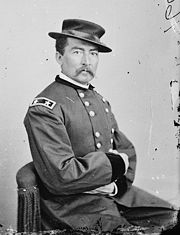
Sheridan
Personal Memoirs of P. H. Sheridan, General, United States Army Volume 1 by Philip Henry, General, 1831-1888 Sheridan – $0.00
Personal Memoirs of P. H. Sheridan, General, United States Army Volume 2 by Philip Henry, General, 1831-1888 Sheridan – $0.00
Personal Memoirs of P.H. Sheridan, both volumes in one file by Philip Henry Sheridan – $0.99
Personal Memoirs of U. S. Grant Volume 1 by Ulysses S. (Ulysses Simpson), 1822-1885 Grant – $0.00
Personal Memoirs of U. S. Grant Volume 2 by Ulysses S. (Ulysses Simpson), 1822-1885 Grant – $0.00
Personal Memoirs of Ulysses S. Grant by Ulysses S. Grant and Mark Twain- $0.99
Letters of Ulysses S. Grant to His Father and His Youngest Sister, 1857-1878 by Ulysses S. Grant and Jesse Grant Cramer – $0.99
Campaigning with Grant (1907, [c1897]), First Person Account of Ulysses S. Grant During the Civil War by Horace Porter – $1.59

Stonewall Jackson
Stonewall Jackson and the American Civil War, both volumes in a single file by Colonel G.F.R. Henderson – $0.99
Stonewall Jackson and the American Civil War by G. F. R. Henderson – $0.99
Stonewall Jackson and the American Civil War by G.F.R. Henderson and Viscount Wolseley – $0.99

Lee
The Life of General Robert E. Lee by Captain Robert E. Lee (his son) – $0.99
A Life of General Robert E. Lee by John Esten Cooke – $0.99
Recollections and Letters of General Robert E. Lee by his son by Captain Robert E. Lee – $0.99
With Lee in Virginia, a Story of the American Civil War by G.A. Henty – $0.99

W. T. Sherman
Memoirs of General William T. Sherman by William T. Sherman – $0.99
Thirteen Months in the Rebel Army by William G. Stevenson – $0.99
Captains of the Civil War – A Chronicle of the Blue and the Gray by William Wood – $0.99
Military Reminiscences of the Civil War, both volumes in a single file by Jacob Dolson Cox – $0.99
Military Reminiscences of the Civil War, Volume 1 by Jacob Dolson Cox – $1.84
Military Reminiscences of the Civil War, Volume 2 by Jacob Dolson Cox – $1.84
Reminiscences of Two Years with the Colored Troops by Joshua M. Addeman – $0.99
Army Life in a Black Regiment by Thomas Wentworth Higginson – $1.00
Heroes of the Great Conflict: Life and Services of William Farrar Smith, Major General, United States Volunteer in the Civil War by James Harrison Wilson – $0.99
The Scouts of Stonewall: The Story of the Great Valley Campaign by Joseph A. (Joseph Alexander), 1862-1919 Altsheler
The Rise and Fall of the Confederate Government by Jefferson Davis
Regimental Histories
History of Company E of the Sixth Minnesota Regiment by Alfred J. Hill – $1.59
Women
Woman’s Work in the Civil War; A Record of Heroism, Patriotism, and Patience by M.D. L. P. Brockett – $1.80
Memories: a Record of Personal Experience and Adventure During Four Years of War by Mrs. Fannie A. Beers – $0.99
Fortifications and Armaments
A History of Lumsden’s Battery, C.S.A. by Dr. George Little and james R. Maxwell – $1.99
History of the Confederate Powder Works by George W. Rains- $1.19
Naval
![the-fight-between-the-alabama-and-the-kearsarge-nh59354 "The Fight Between the Alabama and the Kearsarge" [NH59354]](https://wigwags.files.wordpress.com/2008/09/the-fight-between-the-alabama-and-the-kearsarge-nh59354.jpg?w=700)
The Story of the Kearsarge and the Alabama by A. K. Browne – $0.99
The Cruise of the Alabama and the Sumter, both volumes in a single file by Raphael Semmes- $0.99
Railroads
The Great Railroad Adventure – a True Tale from the American Civil War by Lieut. William Pittenger – $0.99
Prisons
Andersonville: a Story of Rebel Military Prisons, all four volumes in a single file by John McElroy – $0.99
Other Biography

John Wilkes Booth
The Life, Crime & Capture of John Wilkes Booth by George Alfred Townsend – $0.99
Speeches and Legislative Documents
Abraham Lincoln’s Second Inaugural Address by Abraham Lincoln – $0.49
Lincoln’s Gettysburg Address by Abraham Lincoln – $0.49
The Emancipation Proclamation (Preliminary and Final Version) by Abraham Lincoln and William Seward – $0.80
Jefferson Davis’ Inaugural Address by Jefferson Davis – $0.99
Civil War Photography
Taking Photographs During the Civil War – $0.80
Fiction
The Little Regiment and Other Episodes of the American Civil War by Stephen Crane. Published by MobileReference (mobi) by Stephen Crane – $0.99
The Red Badge of Courage by Stephen Crane – $0.99
The Sacking of Lawrence, May 21, 1856 – 5 Beecher’s Bibles
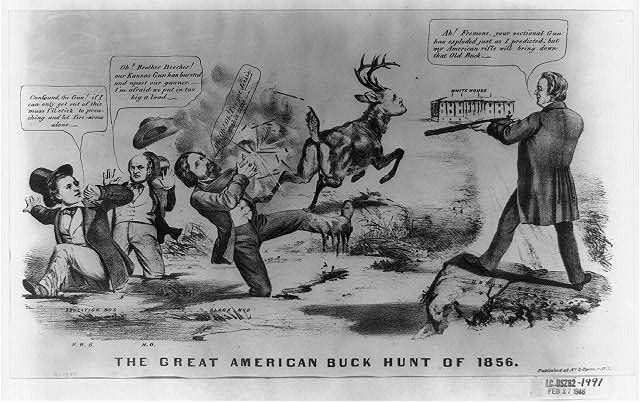
Digital ID: cph 3b37012 Source: b&w film copy neg. Reproduction Number: LC-USZ62-90663 (b&w film copy neg.) , LC-USZ62-1991 (b&w film copy neg.) Repository: Library of Congress Prints and Photographs Division Washington, D.C. 20540 USA
The potential for violence after passage of the Kansas-Nebraska Act, and indeed episodes of violence, increased on the border between Missouri and Kansas as both Free Soiler and pro-slavery factions began actively arming themselves. An agent of the New England Emigrant Aid Society in Kansas, Charles L. Robinson, requested with some urgency a shipment of several hundred rifles and field guns.(i) Guns were sent to aid Free Soilers in Kansas often with the support of northeastern clergy and their congregations. Thus Sharps Rifles sent by Henry Ward Beecher’s congregation became know as “Beecher Bibles”. Likewise, according to Potter, armed militias from the South began forming to support the pro-slavery cause in Kansas. (i)

Henry Ward Beecher (Source: Library of Congress Brady-Handy Photograph Collection (LC-BH82- 5388 A))
This post continues the series, “The Sacking of Lawrence May 21, 1856.” Read Part 1 here, Part 2 here, Part 3 here, and Part 4 here.
ABOUT THE POLITICAL CARTOON: Another Currier satire favoring American party candidate Millard Fillmore. A “buck” (James Buchanan) runs toward the White House, visible in the distance, as the two rival candidates take aim at him with their shotguns. Republican John C. Fremont’s gun explodes (left), as he struggles to free himself from a pool of “Black Mud.” On the far left his two abolitionist supporters Henry Ward Beecher and editor Horace Greeley are also mired in an “Abolition Bog.” Fremont: “Oh! Oh! Oh! I’ve got Jessie this time–” (a puzzling allusion to his wife Jessie Benton). Greeley: “Oh! Brother Beecher! our Kansas Gun has bursted and upset our gunner. I’m afraid we put in too big a load.” Reference is to the Kansas–Nebraska Act of 1854 and the ensuing violence in Kansas, an issue exploited by the Republicans. Beecher: “Confound the Gun! if I can only get out of this muss I’ll stick to preaching and let fire-arms alone.” The oblique reference to Beecher’s part in outfitting armed antislavery emigrants for Kansas is made in more obvious terms in “Col. Fremont’s Last Grand Exploring Expedition in 1856” (no. 1856-20). On “Union Rock” (right), which is square in the path toward the White House, stands Millard Fillmore. He aims his flintlock at Buchanan and says confidently, “Ah! Fremont, your sectional Gun has exploded just as I predicted; but my American rifle will bring down that Old Buck.” MEDIUM: print on wove paper : lithograph ; image 24 x 39 cm. CREATED/PUBLISHED: N.Y. : Published at No. 2 Spruce Street, [1856] Source: Library of Congress
 (i) David M. Potter and Don E. Fehrenbacher, The Impending Crisis, 1848-1861, (New York: Harper and Row Publishers, Inc., 1976), 206.
(i) David M. Potter and Don E. Fehrenbacher, The Impending Crisis, 1848-1861, (New York: Harper and Row Publishers, Inc., 1976), 206.
Yale’s David W. Blight Lectures on the Civil War Era Online at Academic Earth
A friend tipped me off on Friday to a EXCEPTIONAL site, AcademicEarth.org, which provides free audio-visual lecture series of some of the world’s best scholars.
David W. Blight’s entire Spring 2008 term course, The Civil War and Reconstruction Era, 1845-1877, is online for free viewing. Professor Blight is the Class of 1954 Professor of History at Yale University and Director of the The Gilder Lehrman Center for the Study of Slavery, Resistance, and Abolition, also at Yale University.
In addition to the course, presented in an extremely user friendly format, Academic Earth provides a syllabus, reading list (yes I’ve already ordered them all), and full text transcripts of all lectures. GOLD MINE.
I’ve made it through 13 of 27 lectures and they are both outstanding and mesmerizing. HIGHLY RECOMMEND!
The Sacking of Lawrence, May 21, 1856 – 1

Ruins of the Free State Hotel, Lawrence, Kansas. From a Daguerreotype. (The Kansas State Historical Society)
One of the most surprising things I learned from reading Michael F. Holt’s exceptional book, The Political Crisis of the 1850’s, was that the “Sacking of Lawrence” was not the murderous affair I had always thought it was. It led to further research on my part and the realization that I was guilty of combining the stories surrounding the raid on Lawrence with other violent events occurring in the region, an area in which I am a resident. As is often the case with history, I had developed a mythical sense of the day, one that went well beyond the simple destruction of property. This new post series summarizes the findings of my search for the truth about the events of May 21, 1856. Its writing helped to crystallize my understanding of why the Kansas and Missouri borderland became such a focal point for politics in the 1850s. It also revealed that there has been much liberty with the facts and that even today, historians do not agree on all of the specifics.
The Civil War in Missouri – Top Notch Website
There are some terrific sites out there about the American Civil War. The Civil War in Missouri is one of the best.
Among my favorite features in the historical section is a collection of “Animated Battles” that combine audio, film of enactors, and battle maps with action depicted by moving units, fires that blaze, and the sounds of hoof beats and rifle fire. Very cool. This is a great site for students.
Next Term’s Books are In! Mostly…
Ah the thrill of the sound of book boxes being dropped on my front porch and then the doorbell ringing. Nothing like it!!

One of two Amazon boxes delivered today.
Just over half of my books arrived today for next term’s class, Civil War Strategy and Tactics. See related post here.
I had to put them on my bookcase where I won’t open them until after finals. Too much to do before the term ends. Torture.
Apologies for short post. Know you’ll understand. Two papers due by Sunday and need to read the last two chapters of Holt. 
Civil War Movie – American Drummer Boy
This week, I had the opportunity to view the independent film American Drummer Boy by Writer/Director C. Dorian Walker and producer, Elain Nogay Walker. The story takes place in the Western Theater of the American Civil War and chronicles the coming-of-age of young Johnny Boone (Cody Newton) who runs away from his Kentucky farm in hopes of joining his hometown unit, Company A of the 11th Kentucky Infantry, U.S. His adventures take him behind Confederate lines where he is captured and accused of being a spy. With the help of a shady English minstrel, Reginald T. Deets (Clay Watkins), he escapes but is forced to mascaraed as a Rebel drummer with the 24th Mississippi Regiment. He experiences battle on the other side before eventually escaping to the North and finding his unit. There, while serving as drummer boy, he demonstrates valor under fire and is awarded the Medal of Honor (this a true occurrence).
Walker bases the storyline on a compilation of true events. Those events are described in some detail in a companion documentary, Call to War, also on the DVD, which is quite good and includes interviews with historians such as Bill Bright, Curator of the Kentucky Historical Society. It tells the true stories of William Horsfall, 14, who became one of the youngest recipients of the Medal of Honor and Asa Lewis who, although serving with distinction, was sentenced to death before a firing squad of his own unit because he went home to help his recently widowed mother put a crop in.
Two performances stand out in the film. Cody Newton (X Files, The Movie) is quite good in his lead role of young Johnny Boone (pictured above). Clay Watkins also does an admirable job as Reginald T. Deets, Johnny’s sometimes mentor. The music score by Eric Colvin is outstanding.
The film will be of interest to Civil War re-enactors because of its attention to historical details and would be perfect for young audiences as a teaching tool for the American Civil War. The team has put together a nice website which includes teacher resources available here. Recommend.
Beginning a search for a thesis topic…The American Civil War
I am going to begin in earnest to find a suitable topic for my thesis. I don’t expect to have one locked in until I get another course or two under my belt but I am interested in the opinions of many of you who I would consider expert on topics of Civil War military history. Where are there gaps in scholarship that need filling from your perspective?
Let me hear from you!
On Slavery 9 – Partus Sequitur Ventrem
When considering slaves, Colonial Virginians abandoned the English tradition of partus sequitur patrem (one’s status was determined by the disposition of their father) in favor of the Roman principle of partus sequitur ventrem, a “child inherits the condition of the mother.” (1) Thus offspring of slave women were the property of their mother’s owner whether fathered by freeman or not. Annette Gordon–Reed, in her book “The Hemingses of Monticello: An American Family,” speculates on why Virginian colonists made up this particular form of slavery that endured until the Civil War.
“White men, particularly the ones who made up the House of Burgesses, the legislature in colonial Virginia, were the masters of a growing numbers of African women, owning not only their labor but their very bodies. That these women sometimes would be used for sex as well as work must have occurred to the burgesses. Inevitably offspring would arise from some of these unions. Even white males who owned no slaves could contribute to the problem by producing, with enslaved black women, children who would be born free, thus destroying a critical component of the master’s property right: the ability to capture the value of the “increase” when female slaves gave birth.” (2)
Gordon-Reed goes on to describe an actual court case that occurred in 1655 in which Elizabeth Key, a woman of mixed blood, “successfully sued for her freedom on the basis of the fact that her father was English.” (3) This ruling, if left to stand as precedent, would have created a gap by which a growing number of children could escape slavery, those fathered by free white men and black women in bondage.
The impacts were staggering. First, the law “assured that white men – particularly the privileged ones who passed the law, who would not likely have been hauled into court for fornication even with white women – could have sex with enslaved women, produce children who were items of capital, and never have to worry about losing their property rights in them.” (4)
Gordon-Reed suggests that the law was likely intended to reduce racial-mixing in that along with it was passed a measure that increased the fines for mixed-race couples that engaged in sex out of wedlock. But in effect, it meant “the private conduct of men would have no serious impact on the emerging slave society as a whole. White men could engage in sex with black women without creating a class of freeborn mixed-race people to complicate matters.” (5)
Second, the law implied that every person suspected of having African blood, was assumed to be a slave unless they could prove otherwise. “…The English common-law presumption in favor of freedom did not apply to Negroes; in all slave states (except Delaware) the presumption was that people with black skins were slaves unless they could prove that they were free.” (6) Kenneth Stampp explains that this hyper race sensitive system required that “the offspring of a free white father and a Negro, mulatto (half), quadroon (one Negro grandparent), or octoroon (one Negro great-grandparent) slave mother was a slave.” (7) This ruling once again encouraged exploitation of women in that mixed-blood, often very white appearing women, were kept as slave prostitutes to service white men.
 Paradoxically, the child of a black enslaved father and a free white mother was considered by law in most states, free. Likewise, children found to have descended from a female Indian were considered free because, with the exception of a short time in the 17th century, it was unlawful to enslave an Indian.
Paradoxically, the child of a black enslaved father and a free white mother was considered by law in most states, free. Likewise, children found to have descended from a female Indian were considered free because, with the exception of a short time in the 17th century, it was unlawful to enslave an Indian.
As might be imagined, interpretation of the rules governing race and thus one’s status as property varied by locale. “In Alabama a ‘mulatto’ was ‘a person of mixed blood, descended, on the part of the mother or father, from negro ancestors, to the third generation inclusive, though one ancestor of each generation may have been a white person.” (8) South Carolina didn’t specifically define terms such as Negro and mulatto but left interpretation to visible evidence of mixture and took into account “a person’s reputation among his neighbors.” (9) One was considered free in Kentucky if it could be proven that one had “less than a fourth of African blood.” (10)
The legacy of the men who created a country built upon laws that supported racial slavery was in part the creation of a culture that expended a great deal of energy establishing the racial status and thus property rights to a growing population of mix-blood “chattel personal.” It was a legacy that encouraged widespread abuses and the flagrant misuse of female slaves who had no legal rights at all. As contended by Gordon-Reed, “under the rules of the game the burgesses constructed,” there was no need to interfere with other men’s conduct. Whatever the social tensions and confusion created by the presence of people who were neither black nor white, Virginia’s law on inheriting status through the mother effectively ended threats to slave masters’ property rights when interracial sex produced children who confounded the supposedly fixed categories of race.” (11) Hyper-race sensitivity and all its implications would continue for centuries to come.
For more information on Elizabeth Key’s freedom case, see a paper by Taunya Lovell Banks from the University of Maryland School of Law, “Dangerous Woman: Elizabeth Key’s Freedom Suit – Subjecthood and Racialized Identity in Seventeenth Century Colonial Virginia” here.
(1) Kenneth M. Stamp, The Peculiar Institution: Slavery in the Ante-Bellum South, (New York: Vintage Books, 1956), 193.
(2) Annette Gordon – Reed, The Hemingses of Monticello: An American Family, (New York: W. W. Norton & Company, 2008), 46.
(3) Ibid.
(4) Ibid.
(5) Ibid., 46-47.
(6) Kenneth M. Stamp, The Peculiar Institution: Slavery in the Ante-Bellum South, 193-194.
(7) Ibid., 194.
(8) Ibid., 195.
(9) Ibid.
(10) Ibid., 196.
(11) Annette Gordon – Reed, The Hemingses of Monticello: An American Family, 47.
Book Review: Two Brothers, One North, One South
Jones, David H. Two Brothers, One North, One South. Encino, CA: Staghorn Press, 2008. 320pp, ISBN 13: 978-0-9796898-5-7, $24.95.
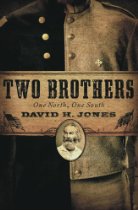 In his historical novel, David H. Jones tells the story of the the Prentiss brothers, William and Clifton, who fight on opposite sides of the American Civil War. The primary narrator is era poet, Walt Whitman, who befriends a dying William in the military hospital at the close of the war. In the young Confederate’s final days, he recounts to Mr. Whitman his experiences which Whitman, in turn, finds opportunity to share with brother Clifton, a Union officer, who lies wounded in the same hospital. They are joined by family members who collect around Clifton following William’s death.
In his historical novel, David H. Jones tells the story of the the Prentiss brothers, William and Clifton, who fight on opposite sides of the American Civil War. The primary narrator is era poet, Walt Whitman, who befriends a dying William in the military hospital at the close of the war. In the young Confederate’s final days, he recounts to Mr. Whitman his experiences which Whitman, in turn, finds opportunity to share with brother Clifton, a Union officer, who lies wounded in the same hospital. They are joined by family members who collect around Clifton following William’s death.
The story tells of young Southern men dashing off to join the fight and courageous Southern women who persuade politicos to contribute arms and supplies to Southern recruits and who even become blockade runners to ensure that those supplies reach the troops. We are witness to a number of key battles of the war, introduced to the weapons used, and generally educated about what it would have been like to serve in, primarily, the Confederate ranks. There is significantly less information provided through the storyline about the war experiences of brother Clifton and the Northern perspective.
What is unique about the novel is that the brothers featured were real and many will find the facts surrounding their lives, so carefully researched, intriguing. The presentation of the novel is also stylistically unique in that it is written using the formal language of the era.
I had the sense in reading Two Brothers that Jones struggled to nail down the book’s genre as he set about writing it. The work often resembles non-fiction with much “telling” of history rather than the “showing” of character-driven action and drama that makes for good fiction. While the “telling” made for interesting history, as a piece of fiction, the book was less than satisfying. That said, Civil War buffs will enjoy the military aspects of the book which are well researched.
Lincoln and His Admirals
I’m very pleased to have received a review copy yesterday of Lincoln and His Admirals by Craig L. Symonds from the terrific folks over at Oxford University Press. You can view the book’s listing at OUP here. Being a student of both the American Civil War AND maritime history, I can’t think of a better read. I’m reserving this one for the Christmas holiday. This will also be my first introduction to the work of Craig L. Symonds. More to come on my review.
Hardcover: 448 pages
Publisher: Oxford University Press, USA (October 17, 2008)
ISBN-10: 0195310225
ISBN-13: 978-0195310221
Dimensions: 9.2 x 6.3 x 1.5 inches
Link Updates
Over the weekend, I added quite a few links to the right navbar which I use to keep myself organized. Here’s a quick run down of several of the new adds. There’s a theme in here somewhere….
- Links to all state historical societies
- The Historical Maritime Society
- Smith’s Master Index to Maritime Museums (WOW!)
- Portsmouth Historic Dockyards (GO if you get a chance!)
- Five excellent new links to sites related to slavery filed under “Slavery Links”
Abraham Lincoln: A Presidential Life
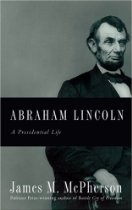 Yesterday, I was pleased to receive a review copy of James M. McPherson’s upcoming release, Abraham Lincoln: A Presidential Life from Oxford University Press. It is scheduled to be released on the date marking the 200th year since Lincoln’s birth. While I’ve yet to complete it, I was impressed by Dr. McPherson’s candor in the introduction about his own shift in opinion about Lincoln and his presidency. While initially critical of Lincoln, not unlike the abolitionists of the era of his presidency, McPherson’s years of study brought new appreciation for Lincoln’s skills as an adroit commander-in-chief tasked with challenges of incredible complexity.
Yesterday, I was pleased to receive a review copy of James M. McPherson’s upcoming release, Abraham Lincoln: A Presidential Life from Oxford University Press. It is scheduled to be released on the date marking the 200th year since Lincoln’s birth. While I’ve yet to complete it, I was impressed by Dr. McPherson’s candor in the introduction about his own shift in opinion about Lincoln and his presidency. While initially critical of Lincoln, not unlike the abolitionists of the era of his presidency, McPherson’s years of study brought new appreciation for Lincoln’s skills as an adroit commander-in-chief tasked with challenges of incredible complexity.
Hardcover: 96 pages
Publisher: Oxford University Press, USA (February 1, 2009)
Language: English
ISBN-10: 0195374525
ISBN-13: 978-0195374520
Product Dimensions: 8 x 5.1 x 0.7 inches
On Slavery – 5 Escaping
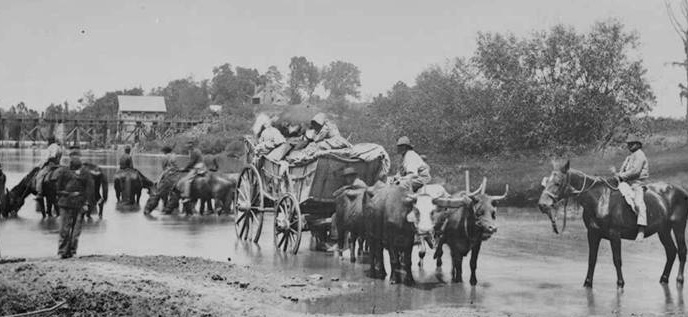
Historian Kenneth Stampp makes an interesting point about differing locations of slaves determining the destination of escapees. Those living near Indians might, for example, seek refuge with local tribes, as was the case in Florida.
“…Florida slaves escaped to the Seminole Indians, aided them in their wars against the whites, and accompanied them when they moved to the West. At Key West, in 1858, a dozen slaves stole a small boat and successfully navigated it to freedom in the Bahamas. Arkansas runaways often tried to make their way to the Indian country.” (Stampp, 120)
Those nearer to the north often choose to escape to the north where there was a greater presence of abolitionists.
Those in Texas would escape in larger numbers to Mexico.
“In Mexico the fugitives generally were welcomed and protected and in some cases sympathetic peons guided them in their flight.” (Stampp, 120)
Kenneth M. Stampp, The Peculiar Institution: Slavery in the Ante-Bellum South
On Slavery – 4

Cotton Harvest, U.S. South,1850s Reference BLAKE4, as shown on http://www.slaveryimages.org, sponsored by the Virginia Foundation for the Humanities and the University of Virginia Library.
The experience of slaves could vary by region due in large part to the type of product the slave was engaged in bringing to market. Slaves in the hemp producing regions of Kentucky and Missouri, worked in rhythm with the cycles required by the crop. Similarly, slaves who worked in cotton producing areas (above) or regions in which tobacco was cultivated, would have had daily and seasonal work routines aligned with those crops. Regional weather would also have differentiated the experience of slaves in different parts of the south.
Slaves rented out to work in industrial areas with factories would have had a decidedly different experience than those working on a plantation. Author Kenneth Stampp suggests that factory slaves enjoyed more freedom and yet an equal if not higher incidence of overwork. The daily experience of slaves living in urban centers would have been decidedly different than rural slaves. Domestic assignments were not uncommon.
On Slavery – 1

Photograph of Slave Cabin and Occupants Near Eufala, Barbour County, Alabama (Photo source: Library of Congress)
I’m reading Kenneth M. Stampp’s fascinating book, The Peculiar Institution: Slavery in the Ante-Bellum South for class. A focus this week and next is, among other things, the ways in which slave owners controlled their bondsmen. The methods varied considerably as did the ethical sensibilities of the masters and overseers. Stampp suggests that behavioral control included both the carrot and the stick with heavy weighting on the stick. That is to say, some masters and/or overseers used positive incentives and some negative.
Positive incentives included: work stoppage at noon on Saturdays and Sunday off, holidays off, parties and dances, holiday gifts, cash for the best worker for a given period, the right to grow one’s own crops whether for personal food or sale, the right to rent oneself out and keep some of the income, and the ultimate incentive, the right to achieve freedom.
Negative incentives were many. Stampp suggests that few adult slaves did not have some experience with flogging. This seemed to be the most acceptable method of disciplining slaves and was used extensively. Other forms of physical punishment used to control slaves included: confinement either in “the blocks” or even jail, mutilation (ranging from castration to branding), and even more severe forms of torture. For young slaves or those who needed “breaking,” there were actually specialists who through, undoubtedly mental and physical persuasion, reduced high spirited individuals to more pliable and subservient workers.
Another method of control was the introduction of religion to the slaves. Indoctrination of slaves into Christianity had its advantages. It was not uncommon for them to ensure that sermons emphasized those verses in the Bible that instructed servants to obey their masters. (Stampp, 158) Particular focus was made on teaching slave children “respect and obedience to their superiors” in the belief that it made them better servants. (Stampp, 159) This suggests a fascinating area of study – the effects of religion on American slaves – for which I must look for information. Let me know if you can recommend any.
Civil War Battlefield Assessment – Vicksburg National Military Park Scores only “Fair”
On October 29, 2008, the National Parks Conservation Association’s Center (NPCA) for the State of the Parks released the first of ten Civil War park assessments. It presented a “good news – bad news” story. According to Perry Wheeler, with the NPCA, the Vicksburg assessment…
“…finds that overall conditions of the park’s known cultural resources rated a score of 67 out of 100, indicating fair conditions. This score includes ratings for the park’s historic structures, cultural landscapes, archaeology sites, and extensive museum collection.” [The Vicksburg assessment is available in its entirety by clicking here.]

National Park Service Photo: Vicksburg National Military Park commemorates the siege of Vicksburg and the ensuing battle, widely considered one of the most important campaigns of the Civil War.
Wheeler indicated that a recent grant of $142,000, “received as part of the National Park Centennial Challenge program, additional maintenance funding and staff needs” will help, but it’s only a start.
“NPCA’s assessment found that the park is in need of an additional 9.4 full-time employees and roughly $716,000 in funding, which obviously the grant will help with. The park currently has only two full-time cultural resource staff: a historian and a museum curator.
Furthermore, Vicksburg’s interpretive staff consists of only two interpreters, two guides, and one supervisory park ranger — not enough to serve the 700,000 people who visit the park each year. Current staff levels equal 140,000 visitors per ranger each year!!”
If you’re not a supporter, consider becoming one or help spread the word.
Find out how on the Civil War Preservation Trust site here.
The Vicksburg National Military Park photostream on flickr is available here.
For the Common Defense
Peter Maslowski and Allan R. Millett. For the Common Defense: A Military History of the United States of America. Enlarged edition. Simon & Schuster, 1994. See the book on publisher’s site here.
This monumental survey of American military history has three stated purposes. The first is to analyze the development of military policy. The second is to examine the characteristics and behavior of the United States armed forces in the execution of that policy and the third is to illuminate the impact of military policy on America’s international relations and domestic development. Millett and Maslowski propose that there are six major themes that position military history within the larger context of American history. These include the following and are quoted from the text.
- Rational military considerations alone have rarely shaped military policies and programs. The political system and societal values have imposed constraints on defense matters.
- American defense policy has traditionally been built upon pluralistic military institutions, most
 notably a mixed force of professionals and citizen-soldiers.
notably a mixed force of professionals and citizen-soldiers. - Despite the popular belief that the United States has generally been unprepared for war, policy makers have done remarkably well in preserving the nation’s security.
- The nation’s firm commitment to civilian control of the armed forces requires careful attention to civil-military relations.
- The armed forces of the nation have become progressively more nationalized and professionalized.
- Beginning in the mid-nineteenth century, but especially during the twentieth century, industrialization has shaped the way the nation has fought.
The authors further suggest that Americans do not consider themselves a warring people but have in fact become involved in a number of conflicts and that because of this, the study of the United States’ military history is important in if one hopes to gain better insight into both America’s history and its current and future identity.
Millett and Maslowski structure their book chronologically, which is completely fitting. They begin with a survey of colonists from 1609 – 1689. They devote a chapter as well to the Colonial Wars that occurred between 1689 and 1763. The American Revolution follows and includes the years between 1763 and 1783. Two chapters cover the military history of the new republic including its expansion. This includes the period 1783 – 1860 after which the country is on the precipice of civil war. Two chapters are devoted to the American Civil War the first focusing on the early years of 1861 and 1862. The second surveys the years between 1863 and the war’s end in 1865. And so the format continues covering major years of either military growth or conflict through to two great wars. Several chapters are devoted to the period spanning the Cold War during which the Korean War took place. The Vietnam War covers the period from 1961 – 1975. The periods marking the end of the Cold War follow and then a chapter is devoted to the Gulf War.The book was written and published in its revised format prior to the Iraq War.
Millett and Maslowski’s work provides outstanding bibliographies expanded in the revised edition to include selected references at the end of every chapter as well as a generous General Bibliography. It also includes an excellent set of illustrations and photographs. This work is intended for students of American military history and American history in general. It should also appeal to the reader who wants a perspective on the events of world history in which the American military has been engaged.
Both authors bring impeccable credentials to their authorship of this text. Allan R. Millett (see his 2007 vitae here) is the Raymond E. Mason Jr. Professor Emeritus of History from The Ohio State University. He is the Stephen Ambrose Professor of History at the University of New Orleans and Director of the Eisenhower Center  for American Studies at the National World War II Museum in New Orleans. He received his B.A. in English from DePauw University and his M.A. and Ph.D. in History from The Ohio State University. He is a retired colonel of the Marine Corps Reserve, and a specialist in the history of American military policy and 20th century wars and military institutions. He is one of the founders of the military history program at The Ohio State University. Dr. Millett was recently honored with the 2008 Pritzker Military Library Literature Award for Lifetime Achievement in Military Writing (see the news release here).
for American Studies at the National World War II Museum in New Orleans. He received his B.A. in English from DePauw University and his M.A. and Ph.D. in History from The Ohio State University. He is a retired colonel of the Marine Corps Reserve, and a specialist in the history of American military policy and 20th century wars and military institutions. He is one of the founders of the military history program at The Ohio State University. Dr. Millett was recently honored with the 2008 Pritzker Military Library Literature Award for Lifetime Achievement in Military Writing (see the news release here).
Peter Maslowski is Professor of History at the University of Nebraska where he specializes in the history of the Civil War, military, and Vietnam War. He received his B.A. from Miami University and M.A. and Ph.D. from The Ohio State University. Professor Maslowski served as the John F. Morrison Professor of Military History at the U.S. Army Command and General Staff from 1986 to 1987. In 2002, Professor Maslowski, a highly regarded teacher/lecturer, received the Outstanding Teaching and Instructional Creativity Award (OTICA). He is on the Advisory Board of the Gilder Lehrman Institute of American History. For an excellent interview with Professor Maslowski on his career, see the 2005 interview in the Daily Nebraskan here
I have found no other resource on U.S. Military History that is so comprehensive in nature. Recommend.
Civil War Blog Addition and British History Online
I’ve made some additional adds to my blogroll and links. First a belated welcome to Jim Beeghley whose blog, “Teaching the Civil War with Technology” has not only a strong premise but some terrific posts.
Welcome Jim! http://blog.teachthecivilwar.com
And thanks to Alex Rose over at The History Man blog for a lead to British History Online. This is an impressive site with some great information including primary sources. I’ve added it under a new category titled History Sites of Merit.
New Arrival – Tried by War: Abraham Lincoln as Commander in Chief
This week I received a review copy of James M. McPherson’s new work, Tried by War: Abraham Lincoln as Commander in Chief from the good folks at Penguin Press. Needless to say, I’m very much looking forward to diving in as Dr. McPherson’s books on Lincoln remain among my favorites.
He opens the book with the following.
“The insurgent leader…does not attempt to deceive us. He affords us no excuse to deceive ourselves. He can not voluntarily reaccept the Union; we can not voluntarily yield it. Between him and us the issue is distinct, simple, and inflexible. It is an issue which can only be tried by war and decided by victory.”
—Lincoln’s annual message to Congress,
December 6, 1864
Tried by War
Abraham Lincoln as Commander in Chief
James M. McPherson – Author
Hardcover | 6.14 x 9.25in | 384 pages | ISBN 9781594201912 | 07 Oct 2008 | The Penguin Press
Sweetsmoke by David Fuller
This weekend I finished David Fuller’s novel, Sweetsmoke, which I first mentioned on WigWags here.
A work of fiction can be judged by many criteria. My approach is pretty simple.
1) Did it keep my interest past page five?
2) Did I find myself wanting to set other pressing activities aside to return to the story?
3) Did the characters grab me?
4) Was the writing such that I could see what the characters see?
5) If a mystery, did it keep me guessing?
6) Did I learn something?
7) Was I a bit blue the day after I finished it because — I didn’t want to be finished?
8) Would I recommend it to family, friend, or colleague?
Here is my run down on Sweetsmoke. The numbered answers below correlate, of course, to the aforementioned questions above.
1) By the time I thought about whether the story had held my interest past page five, I’d just finished Chapter 5. Enough said on that one.
2) My finances remain in a growing “to do” pile.
3) The protagonist, Cassius Howard, was entirely satisfying as the central player in the story. I found particularly intriguing his relationship with his owner, Hoke Howard. And what a fresh idea to make the “sleuth” of the murder mystery that is the undercurrent of the story, a plantation slave.
4) I found Mr. Fuller’s descriptive writing excellent. His recounting of the Battle of Antietam (see Antietam National Battleground link here), was shockingly realistic and worth the price of the book alone. He is a master of “showing,” not telling. Well done.
5) The mystery’s twists and turns definitely kept me guessing. I won’t reveal anything here…
6) While I was familiar with the history, Mr. Fuller’s description of plantation life from the slave’s perspective was insightful. Many readers will benefit from the historical aspects of the book.
7) I am completely miffed that I don’t get to continue the story this evening.
8) I just this minute loaned my copy to my sister to read on her vacation. She and her daughter will likely fight over it. Vacation reading is sacred. Only the best.
Next Class: Antebellum America: Prelude to Civil War
After a short break, I’ll be diving into my next class which starts November 3rd. As is my custom, I’ve added this to “The Courses” page.
“Antebellum America: Prelude to Civil War” (starts November 3rd)
This course is an analysis of the conditions existing in the United States in the first half of the 19th century. The course focuses on the political, cultural/social, economic, security, leadership, and other issues that played roles in starting and shaping the Civil War. We will analyze the issues in the context of war and peace to determine whether or not such conflicts as civil wars can be avoided prior to their inception.
Required Texts:
TBD once the syllabus is available. For now, the list is as follows which is very light in comparison with my last class:
 Publisher: W. W. Norton and Company
Publisher: W. W. Norton and CompanyHalf Slave and Half Free : The Roots of Civil War by Bruce Levine
Road to Disunion : Secessionists at Bay, 1776-1854, Volume 1 by William W. Freehling
Some Press for Wig-Wags
I’m pleased to report that Wig-Wags has been featured on the following sites in the past 30 days:
Indiana University Press found my review of Edward Hagerman’s book, The American Civil War and the Origins of Modern Warfare. You can read their post here and my full review here.
Jessica Merritt included Wig-Wags in her story titled, “100 Awesome Blogs for History Junkies” along with several of my fellow bloggers. Look for me under the “Academic” header. I only wish I could have been listed under several headers.
And finally, Alltop has listed Wig-Wags on their Top History News page. Alltop has a neat layout. They are effectively a feed aggregator by topic that pulls in the latest posts on sites that meet a topical criteria. Readers can “mouse over” any of the top feeds for a site and the full story will be visible as a pop-up of sorts. I like it!
New Addition – Sweetsmoke by David Fuller
I received a review copy of David Fuller’s Sweetsmoke today from the good folks at Hyperion and very much look forward to reading it and passing along my impressions. Mr. Fuller is a screenwriter by profession. He has an interesting lineage of combatants in the American Civil War, which you can read more about on his website here.

